 Can’t ever seem to capture that perfect shot of the Golden Gate Bridge? Photographer and author Lee Foster shares his top five tips.
Can’t ever seem to capture that perfect shot of the Golden Gate Bridge? Photographer and author Lee Foster shares his top five tips.
If you happen to be traveling to San Francisco soon, with a camera in hand, you may be wondering, “Where can I get some good shots?”
Even if you’re not a photographer, you may wonder, “Where can I get some good views?”
Here are my tips to make your photographic/viewing adventure successful.
1. Savor a sunset glow on the Golden Gate Bridge.
There are two terrific places to be from 3 p.m. to sunset. Get a good paper map or print out a Mapquest/Google map in advance to plot your course.
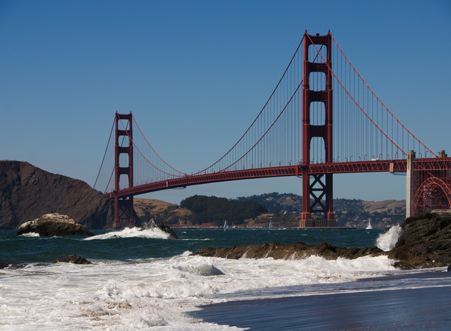 Within San Francisco, go to Baker Beach, west of the Golden Gate Bridge on the north shore of the City. Baker Beach presents an expansive oceanside walk with crashing waves in front of you. It’s the cover photo on my book.
Within San Francisco, go to Baker Beach, west of the Golden Gate Bridge on the north shore of the City. Baker Beach presents an expansive oceanside walk with crashing waves in front of you. It’s the cover photo on my book.
The other choice site is in Marin County on Conzelman Road, the first exit after you leave the north side of the Bridge. Turn onto Conzelman and snake your way west as the road curves through the Marin Headlands.
There are three turnouts for stops: The first is at Battery Spencer, a World War II gun emplacement next to the North Tower of the Golden Gate Bridge; the second is the turnout a quarter mile west, a classic postcard-view stop; the third is a small road that angles left off the main road, the first possible turn to the left. Drive to the end of this small road, and you’re at Hawk Hill, a panoramic view of the Golden Gate.
Get San Francisco travel advice with our Off the Brochure Guide to San Francisco.
2. Indulge in a morning walk at Crissy Field, arguably one of the most glorious urban walks on the planet.
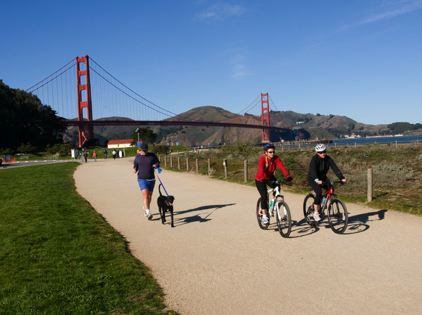 The light is beautiful in the morning, from dawn until about 11 a.m. Transport yourself to Crissy Field and start near the Marina Green/St. Francis Yacht Club. Walk towards the Golden Gate Bridge.
The light is beautiful in the morning, from dawn until about 11 a.m. Transport yourself to Crissy Field and start near the Marina Green/St. Francis Yacht Club. Walk towards the Golden Gate Bridge.
This is a great people-photo or people-watching opportunity, as all manner of San Franciscans parade in an egalitarian manner. The hikers, bicyclists, joggers, and dog-walkers congregate on this paved bayside path to enjoy the Bay and watch the windsurfers celebrate life on the water. If you want to experience brilliant urban planning and design, Crissy Field is the place.
Bring a windbreaker because it can be chilly any time of the year. The restaurant, aptly named the Warming Hut, offers a pleasing break. Don’t forget a plastic bag for your camera to keep the blowing saltwater mist off your optics.
 3. Sample ethnic San Francisco with a morning walk in Chinatown and an afternoon stroll through North Beach.
3. Sample ethnic San Francisco with a morning walk in Chinatown and an afternoon stroll through North Beach.
Both of these intriguing ethnic neighborhoods must be photographed or viewed on foot. It takes time to watch and wait until a pleasing moment appears in front of you.
Chinatown is better in the morning when the hustle and bustle of shopping occurs. North Beach is a more languorous afternoon experience when café idling might be appropriate.
 For Chinatown, walk Grant from Bush to Broadway. Sometimes a detail can jump out at you and define photographically a subject. Roast ducks hanging in a restaurant window is such a shot. You are likely to see roast ducks at Yee’s Restaurant, 1131 Grant. Go inside and watch the butcher, who may be slicing up beef tongue. You can get a modestly priced lunch here of meat, rice and tea.
For Chinatown, walk Grant from Bush to Broadway. Sometimes a detail can jump out at you and define photographically a subject. Roast ducks hanging in a restaurant window is such a shot. You are likely to see roast ducks at Yee’s Restaurant, 1131 Grant. Go inside and watch the butcher, who may be slicing up beef tongue. You can get a modestly priced lunch here of meat, rice and tea.
After Chinatown, go to Broadway/Columbus, walk on Columbus and you will be in North Beach. Walk southeast one block to Kearney and Columbus to take one of the classic San Francisco photos, showing the old and the new. In front of you will be Francis Ford Coppola’s Zoetrope building, 916 Kearney, a classic structure from Old San Francisco. Behind it, you will observe the signature modern San Francisco building, the Transamerica Pyramid.
Then walk back up Columbus to Washington Square and browse around the streets immediately off the square. Bakeries and coffee shops abound. Caffe Roma, 526 Columbus, would be a good place to pause.
4. Ride the City’s famous Cable Cars, then peruse the innards of the system at the Cable Car “Barn.”
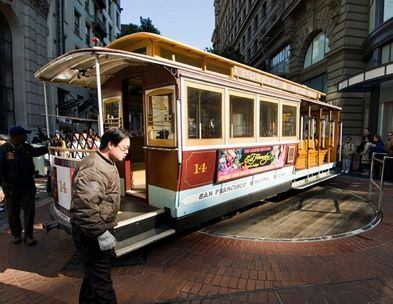 A slice-of-life photo of the Cable Cars is high on most photographers’ to-do list for San Francisco.
A slice-of-life photo of the Cable Cars is high on most photographers’ to-do list for San Francisco.
The Cable Car turnaround at the foot of Powell is interesting to watch and photograph. The busiest coming and going of Cable Cars occurs at Powell and California, where two lines intersect. The classic steep hill shot is from Hyde and Chestnut as the Cable Car climbs Hyde, with the Bay and Alcatraz Island in the background. This last shot is best between noon and 2 p.m. when the sun is high and the Cable Cars are lit rather than in shadow due to tall buildings.
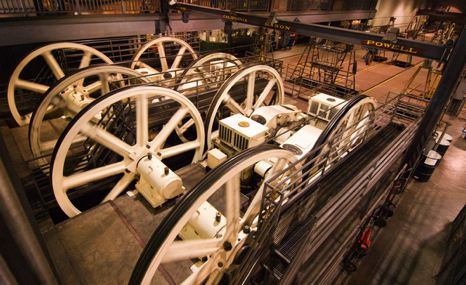 However, beyond these outdoor shots, a fascinating image can be made of the innards of the system, the giant wheels that turn the cable and pull the little Cable Cars around the city. See this at the Cable Car “Barn,” formally known as the Cable Car Museum, 1201 Mason. You will want to ramp up the ISO on your camera or use a tripod because the interior is dark.
However, beyond these outdoor shots, a fascinating image can be made of the innards of the system, the giant wheels that turn the cable and pull the little Cable Cars around the city. See this at the Cable Car “Barn,” formally known as the Cable Car Museum, 1201 Mason. You will want to ramp up the ISO on your camera or use a tripod because the interior is dark.
5. Meander the redwoods at nearby Muir Woods.
San Francisco is so famous for its nearby redwood trees that you owe it to yourself to drive north across the Golden Gate Bridge to Muir Woods in Marin County.
Check out Lee Foster’s 10 Photography Tips for the Icons of Washington, DC.
Follow this plan for best results. Get up early and leave San Francisco at 7 a.m., arriving at Muir Woods by 8 a.m. Drive north on Highway 101 across the Golden Gate Bridge and then west on Highway 1, following the signs.
There are several good reasons for the early morning trip. At 8 a.m. the light is lovely, soft and even, making good photos possible. When the sun gets high and the light gets hot, it is difficult to photograph the brightness and shade together in the redwoods. A more diffuse light is preferable.
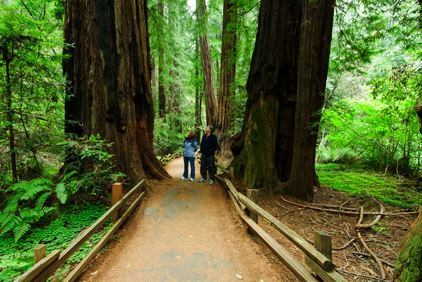 Also, when Muir Woods opens at 8 a.m., the parking is easy, before congestion occurs. With very few people around, you will enjoy a high-quality experience communing with the redwoods. You’ll be able to photograph and walk at Muir Woods and still get back to San Francisco for a photo-filled day.
Also, when Muir Woods opens at 8 a.m., the parking is easy, before congestion occurs. With very few people around, you will enjoy a high-quality experience communing with the redwoods. You’ll be able to photograph and walk at Muir Woods and still get back to San Francisco for a photo-filled day.
For Muir Woods you may want to use a high ISO light sensitivity on your digital camera because the deep woods are fairly dark. Better yet, bring a tripod if you have one. Then set your camera on a low ISO, let the camera take its time, and you will have a photo that can be printed large with minimal pixelation “noise.”
September/October and April/May are the optimal months to photograph or view San Francisco because the light is clear and crisp. Summer can be foggy and winter gray and rainy.
San Francisco is a world-class city to photograph and/or view. My hope is that these notes will help you replicate some of the fun I had spending a year looking at the City for my book.
By Lee Foster for PeterGreenberg.com. Lee’ newest book is The Photographer’s Guide to San Francisco: Where to Find Perfect Shots and How to Take Them (Countryman Press, $14.95). He is also the co-author of the recent book The Photographer’s Guide to Washington DC. See more photos and writing on the Web and order your autographed book at www.fostertravel.com/book.html.
Check out our Off the Brochure Travel Guide to San Francisco, California.
And don’t miss shopper extraordinaire Suzy Gershman’s Guide to Bay Area Baubles.
There’s Offbeat Activities in Northern California in this video.












